Behind the Iron Curtain, there was an interesting film culture. The cinemas of Poland, Russia, East-Germany, Hungary and Czechoslovakia produced several film classics during the 1950s, 1960s and 1970s that fared very well at international film festivals. In Poland, there was also a massive culture of film posters. The best graphic artists of the country designed quite freely innovative images that were spread by hundreds of thousands to every town and village in the country. East-Germany and Romania were the specialists in film postcards. VEB Progress Filmvertrieb had the monopoly on film distribution in East-Germany and produced thousands of wonderderful star postcards to help promote the films.

Yves Montand. East-German postcard by VEB Progress Film-Vertrieb, Berlin, no. 807, 1958. Retail price: 0,20 DM.
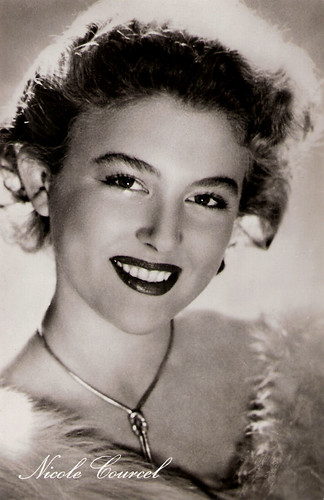
Nicole Courcel. East-German postcard by VEB Progress Filmvertrieb, no. 808, 1958. Retail price: 0,20 DM.
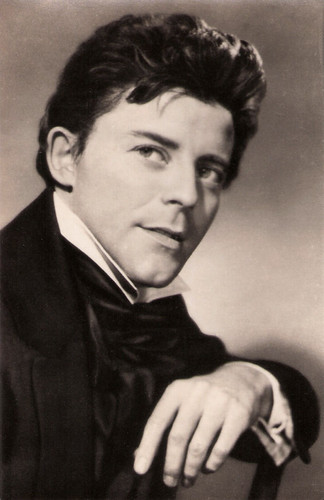
Gérard Philipe. East-German postcard by VEB Progress Filmvertrieb, Berlin, no. 73. Photo: Franco-London-Film S.A. Publicity still for Le rouge et le noir/The Red and the Black (Claude Autant-Lara, 1954).
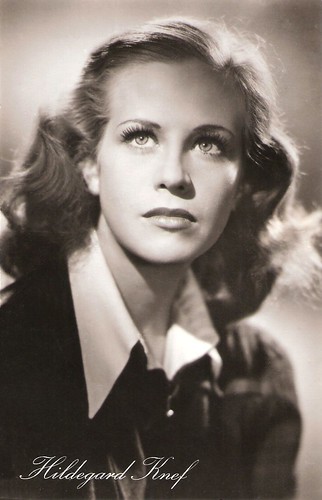
Hildegard Knef. East-German postcard by VEB Progress Film-Vertrieb, Berlin, nr. 7/319. 1957. Photo: DEFA.
Progress was founded in 1950, under German-Soviet management. It was a cooperation of the Russian Sovexport and the East-German DEFA film distribution.
The firm, which still exists, was located in the Jäger Strasse 32 in East-Berlin, in the building of the DEFA Studios for newsreels and documentaries. In 1955, Sovexport retired as a partner and the Progress Film-Vertrieb was transformed in a state-owned company.
In the following decades, Progress produced to promote its films thousands of posters, film programmes and also postcards in different sizes. Regular formats of these 'starpostkarten' were 9 x 13 cm during the 1950s and later 10 x 14,5 cm. These cards had a white edge below the photo. In the 1970s, there were also series with colour postcards and A5 format cards (14,7 x 20,7 cm).
I like the Progress Starpostkarten because they gave a unique view on the popular East-European film stars of the period.
Gojko Mitic for instance, the most famous Indian in Eastern Europe. Between 1966 and 1984, the muscular Serbian actor played in numerous Westerns made in East-Germany.
Or Angelica Domröse, who played the unforgettable Paula in one of the biggest hits of the DEFA, Die Legende von Paul und Paula/The Legend of Paul and Paula (Heiner Carow, 1973). Her co-star Winfried Glatzeder played Paul.
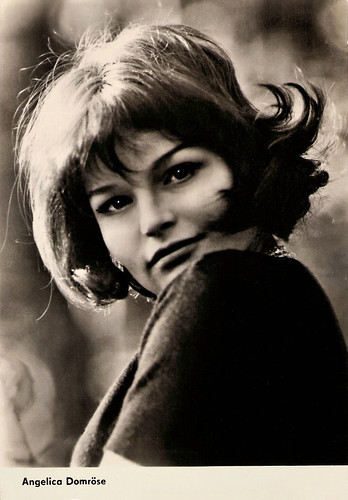
Angelica Domröse. East-German postcard by VEB Progress Filmvertrieb, Berlin, no. 2091, 1964. Retail price: 0,20 DM. Photo: Klaus Fischer.
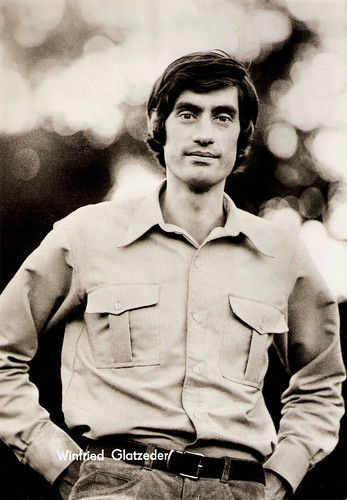
Winfried Glatzeder. Big East-German postcard by VEB Progress Filmvertrieb, Berlin, no. 163/73, 1971. Retail price: 0,50 M. Photo: Linke.

Iurie Darie. East-German postcard by VEB Progress Film-Vertrieb, Berlin, no. 2703, 1966. Retail price: 0,20 M. Photo: Balinski.
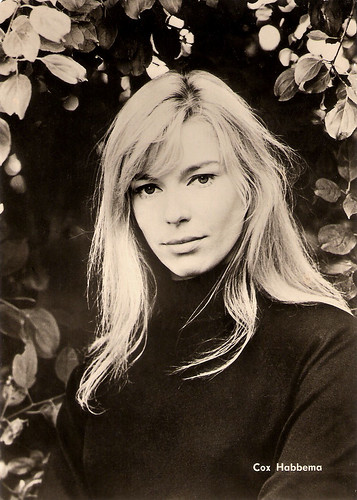
Cox Habbema. East-German postcard by VEB Progress Film-Vertrieb, Berlin, no. 3307, 1968. Retail price: 0,20 DM. Photo: Reinke / DEFA. Publicity still for Wie heiratet man einen König (1968).
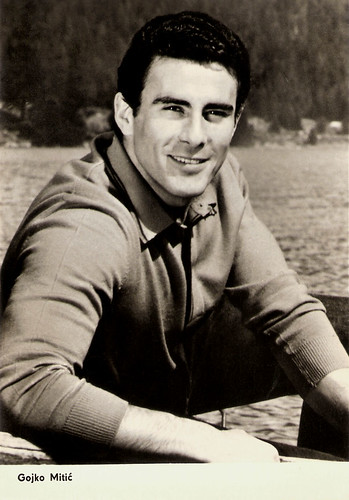
Gojko Mitic. East-German postcard by VEB Progress Film-Vertrieb, Berlin, no. 2930, 1967. Retail price: 0,20 MDN. Photo: Pathenheimer / DEFA.
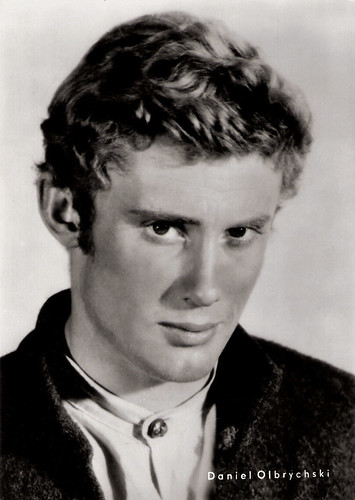
Daniel Olbrychski. East-German postcard by VEB Progress Filmvertrieb, Berlin, no. 117/73, 1973. Retail price: 0,20 M.
The GDR required that 60% of the by Progress distributed films should come from socialist and 40% from non-socialist countries.
So Progress also produced many cards of British, French, Italian and West-German films and its stars. Left-wing stars like Gérard Philipe, Yves Montand and Vanessa Redgrave were obviously popular in East-Germany.
The foreign photographers were not mentioned on these postcards. The only photo credit was 'Progress'. East-German photographers whose work often was used for the Progress cards were Kurt Wunsch and Gerhard Puhlmann in the 1950s , Ludwig Schirmer and Klaus Fischer in the 1960s and Günter Steffen, Peter Söllner and Ute Mahler in the 1970s.
Perhaps surprisingly, Hollywood was a permanent guest in the GDR too. American films were loved by the public, but in the 1950s and 1960s they were only hestitantly imported. This was not only for political reasons. The licenses for the major Hollywood films were expensive for the East-European countries.
In the 1970s more Hollywood films were presented in the East-German cinemas, but with a delay of sometimes ten years. In the early 1980s, the proportion of non-socialist films had grown in some cities to 65% and the share of American films to 23%.
Now, more than 25 years later since the last Progress postcards were produced, there are many collectors like me.
A bit of Ostalghia?
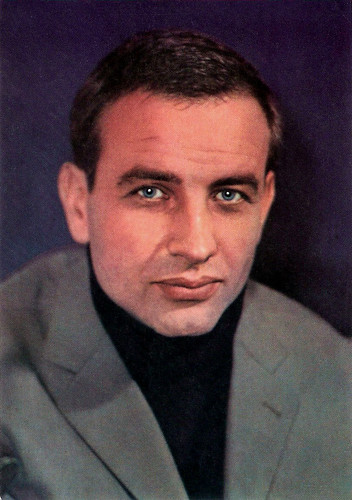
Armin Mueller-Stahl. East-German postcard by VEB Progress Film-Vertrieb, Berlin, no. 2254. Photo: Schirmer.

Eva-Maria Hagen. East-German postcard by VEB Progress Film-Vertrieb, Berlin, no. 2249, 1965. Retail price: 0,15 MDN. Photo: Schwarzer.
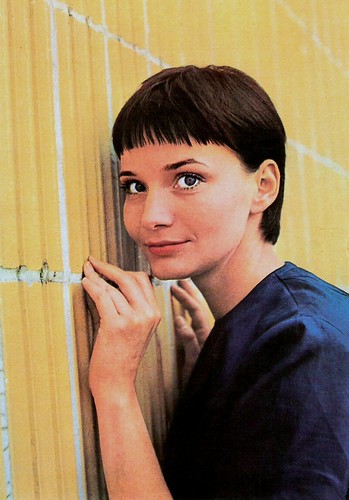
Anna Prucnal. East-German postcard by VEB Progress Film-Vertrieb, Berlin, no. 2259, 1965. Retail price: 0,15 MDN. Photo: Schwarz.
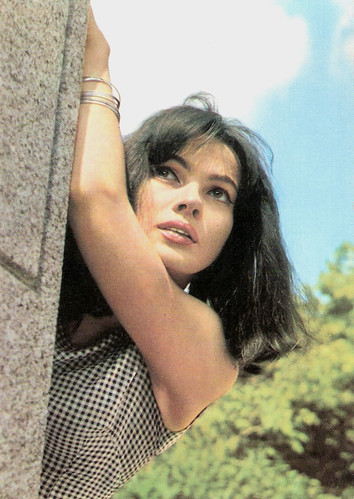
Ewa Krzyzewska. East-German postcard by VEB Progress Filmvertrieb, Berlin, no. 2530, 1966. Retail price: 0,15 MDN. Photo: Balinski.
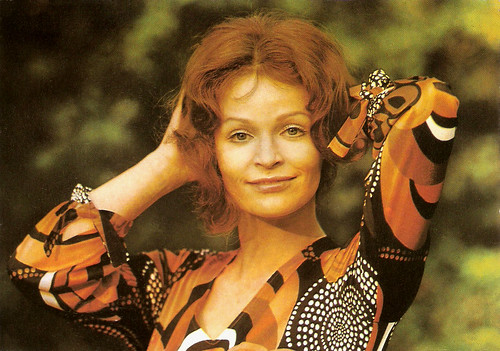
Angelica Domröse. East-German postcard by VEB Progress Film-Vertrieb, Berlin, no. 4/F/73, 1973. Retail price: 0,20 MDN. Photo: Linke.
Next week: the Romanian star postcards of Casa Filmului Acin.
Source: Philipp Humpert (Amerika. Werkleitz festival) (German), Hans-Jürgen Furcht (Archiv Starpostkarten / Schauspielerfotos) (German), Wikipedia (German) and IMDb.

Yves Montand. East-German postcard by VEB Progress Film-Vertrieb, Berlin, no. 807, 1958. Retail price: 0,20 DM.

Nicole Courcel. East-German postcard by VEB Progress Filmvertrieb, no. 808, 1958. Retail price: 0,20 DM.

Gérard Philipe. East-German postcard by VEB Progress Filmvertrieb, Berlin, no. 73. Photo: Franco-London-Film S.A. Publicity still for Le rouge et le noir/The Red and the Black (Claude Autant-Lara, 1954).

Hildegard Knef. East-German postcard by VEB Progress Film-Vertrieb, Berlin, nr. 7/319. 1957. Photo: DEFA.
A State-owned Company
Progress was founded in 1950, under German-Soviet management. It was a cooperation of the Russian Sovexport and the East-German DEFA film distribution.
The firm, which still exists, was located in the Jäger Strasse 32 in East-Berlin, in the building of the DEFA Studios for newsreels and documentaries. In 1955, Sovexport retired as a partner and the Progress Film-Vertrieb was transformed in a state-owned company.
In the following decades, Progress produced to promote its films thousands of posters, film programmes and also postcards in different sizes. Regular formats of these 'starpostkarten' were 9 x 13 cm during the 1950s and later 10 x 14,5 cm. These cards had a white edge below the photo. In the 1970s, there were also series with colour postcards and A5 format cards (14,7 x 20,7 cm).
I like the Progress Starpostkarten because they gave a unique view on the popular East-European film stars of the period.
Gojko Mitic for instance, the most famous Indian in Eastern Europe. Between 1966 and 1984, the muscular Serbian actor played in numerous Westerns made in East-Germany.
Or Angelica Domröse, who played the unforgettable Paula in one of the biggest hits of the DEFA, Die Legende von Paul und Paula/The Legend of Paul and Paula (Heiner Carow, 1973). Her co-star Winfried Glatzeder played Paul.

Angelica Domröse. East-German postcard by VEB Progress Filmvertrieb, Berlin, no. 2091, 1964. Retail price: 0,20 DM. Photo: Klaus Fischer.

Winfried Glatzeder. Big East-German postcard by VEB Progress Filmvertrieb, Berlin, no. 163/73, 1971. Retail price: 0,50 M. Photo: Linke.

Iurie Darie. East-German postcard by VEB Progress Film-Vertrieb, Berlin, no. 2703, 1966. Retail price: 0,20 M. Photo: Balinski.

Cox Habbema. East-German postcard by VEB Progress Film-Vertrieb, Berlin, no. 3307, 1968. Retail price: 0,20 DM. Photo: Reinke / DEFA. Publicity still for Wie heiratet man einen König (1968).

Gojko Mitic. East-German postcard by VEB Progress Film-Vertrieb, Berlin, no. 2930, 1967. Retail price: 0,20 MDN. Photo: Pathenheimer / DEFA.

Daniel Olbrychski. East-German postcard by VEB Progress Filmvertrieb, Berlin, no. 117/73, 1973. Retail price: 0,20 M.
A Bit of Ostalghia
The GDR required that 60% of the by Progress distributed films should come from socialist and 40% from non-socialist countries.
So Progress also produced many cards of British, French, Italian and West-German films and its stars. Left-wing stars like Gérard Philipe, Yves Montand and Vanessa Redgrave were obviously popular in East-Germany.
The foreign photographers were not mentioned on these postcards. The only photo credit was 'Progress'. East-German photographers whose work often was used for the Progress cards were Kurt Wunsch and Gerhard Puhlmann in the 1950s , Ludwig Schirmer and Klaus Fischer in the 1960s and Günter Steffen, Peter Söllner and Ute Mahler in the 1970s.
Perhaps surprisingly, Hollywood was a permanent guest in the GDR too. American films were loved by the public, but in the 1950s and 1960s they were only hestitantly imported. This was not only for political reasons. The licenses for the major Hollywood films were expensive for the East-European countries.
In the 1970s more Hollywood films were presented in the East-German cinemas, but with a delay of sometimes ten years. In the early 1980s, the proportion of non-socialist films had grown in some cities to 65% and the share of American films to 23%.
Now, more than 25 years later since the last Progress postcards were produced, there are many collectors like me.
A bit of Ostalghia?

Armin Mueller-Stahl. East-German postcard by VEB Progress Film-Vertrieb, Berlin, no. 2254. Photo: Schirmer.

Eva-Maria Hagen. East-German postcard by VEB Progress Film-Vertrieb, Berlin, no. 2249, 1965. Retail price: 0,15 MDN. Photo: Schwarzer.

Anna Prucnal. East-German postcard by VEB Progress Film-Vertrieb, Berlin, no. 2259, 1965. Retail price: 0,15 MDN. Photo: Schwarz.

Ewa Krzyzewska. East-German postcard by VEB Progress Filmvertrieb, Berlin, no. 2530, 1966. Retail price: 0,15 MDN. Photo: Balinski.

Angelica Domröse. East-German postcard by VEB Progress Film-Vertrieb, Berlin, no. 4/F/73, 1973. Retail price: 0,20 MDN. Photo: Linke.
Next week: the Romanian star postcards of Casa Filmului Acin.
Source: Philipp Humpert (Amerika. Werkleitz festival) (German), Hans-Jürgen Furcht (Archiv Starpostkarten / Schauspielerfotos) (German), Wikipedia (German) and IMDb.
No comments:
Post a Comment